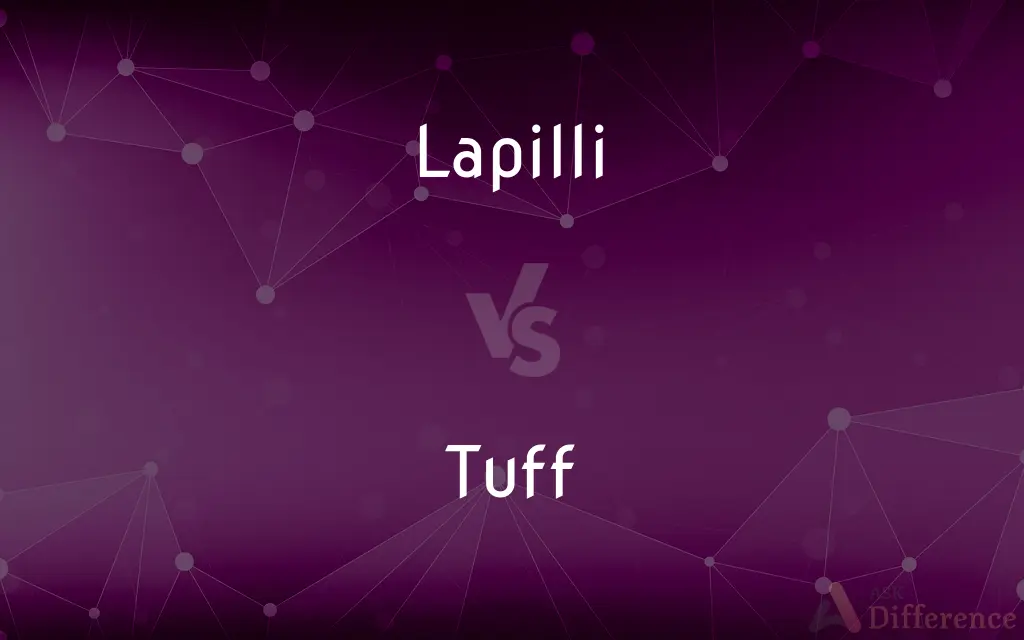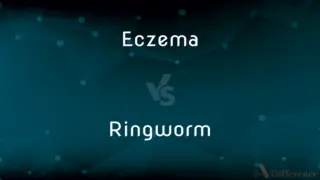Lapilli vs. Tuff — What's the Difference?
By Maham Liaqat & Fiza Rafique — Updated on April 3, 2024
Lapilli are small, solidified fragments expelled during a volcanic eruption, typically 2 to 64 mm in diameter, while tuff is a rock formed from volcanic ash ejected during eruptions, compacted and cemented over time.

Difference Between Lapilli and Tuff
Table of Contents
ADVERTISEMENT
Key Differences
Lapilli are classified based on their size, falling between ash and volcanic bombs in the spectrum of materials ejected by volcanoes. These granular materials are often angular or rounded, indicating their molten or semi-molten state upon ejection. On the other hand, tuff is characterized not by individual particles but by its composition as a rock. It forms when volcanic ash and smaller pyroclastic materials settle and then undergo compaction and cementation, transforming into a solid rock.
The formation process of lapilli involves the cooling and solidification of lava or magma once it is thrown into the air during an eruption. These particles can cool quickly, maintaining a glassy texture, or they can cool more slowly, developing a crystalline texture. Whereas, tuff's formation is a more prolonged process that involves the accumulation of volcanic ash layers that are subsequently buried, compacted, and solidified into rock over time.
Lapilli can vary widely in composition, reflecting the chemistry of the magma from which they originated. This variety can include basaltic, andesitic, or rhyolitic lapilli, each type indicating the nature of the volcanic activity and the magma chamber's characteristics. In contrast, tuff, while also variable in composition, primarily reflects the composition of the ash and materials from which it is formed, including the presence of lapilli-sized fragments within the ash matrix.
The environment of deposition also differs significantly between the two. Lapilli are typically found in proximity to their source volcano, deposited by fallout from explosive eruptions. They often form layers that can be traced back to specific eruptions. Tuff, however, can be found in more extensive deposits, as the fine ash can be carried over longer distances by wind or water before settling and eventually solidifying into rock.
Despite their differences, both lapilli and tuff play crucial roles in understanding volcanic processes and the history of volcanic eruptions. Studying lapilli can provide insights into the conditions of the eruption, such as temperature and magma viscosity, while examining tuff layers can offer a broader perspective on the eruption's extent and the distribution of volcanic ash.
ADVERTISEMENT
Comparison Chart
Definition
Small, solidified volcanic fragments, typically 2 to 64 mm in diameter.
Rock formed from compacted volcanic ash.
Composition
Varies (basaltic, andesitic, rhyolitic), reflecting the magma's chemistry.
Primarily volcanic ash, may include lapilli-sized fragments.
Formation
Cooling and solidification of lava/magma mid-air during eruptions.
Compaction and cementation of volcanic ash and pyroclastic material over time.
Texture
Can be glassy or crystalline, depending on cooling speed.
Generally fine-grained due to the ash, but can be variable if larger fragments are included.
Deposition
Near the volcano, indicating proximity to the eruption source.
Can be more widespread, indicating transport by wind or water.
Compare with Definitions
Lapilli
Small volcanic fragments between 2 and 64 mm.
The ground near the volcano was covered in lapilli, evidencing a recent explosive eruption.
Tuff
Rock formed from compacted volcanic ash.
The cliff face revealed layers of tuff, telling a history of ancient volcanic activity.
Lapilli
Ejected material that cools and solidifies in the air.
Scientists collected lapilli samples to analyze the eruption's characteristics.
Tuff
Undergoes cementation over time to become solid rock.
Over centuries, the volcanic ash bed transformed into a solid tuff layer.
Lapilli
Found in proximity to the eruption site.
The distribution of lapilli helps map the direction of the volcanic blast.
Tuff
Formation indicates the extent of volcanic ash spread.
The wide distribution of tuff layers suggests the eruption was highly explosive.
Lapilli
Can be glassy or crystalline in texture.
The lapilli displayed a glassy texture, indicating rapid cooling.
Tuff
Contains compacted ash and may include larger fragments.
The tuff was interspersed with larger pumice stones, indicating a violent eruption.
Lapilli
Reflects the chemistry of the originating magma.
The andesitic lapilli suggest the magma had intermediate viscosity.
Tuff
Can be fine-grained or contain larger particles.
The tuff's coarse texture was due to the inclusion of lapilli.
Lapilli
Lapilli is a size classification of tephra, which is material that falls out of the air during a volcanic eruption or during some meteorite impacts. Lapilli (singular: lapillus) is Latin for "little stones".
Tuff
Tuff is a type of rock made of volcanic ash ejected from a vent during a volcanic eruption. Following ejection and deposition, the ash is lithified into a solid rock.
Lapilli
A small, solidified fragment of lava.
Tuff
A light, porous rock formed by consolidation of volcanic ash.
Lapilli
Plural of lapillus
Tuff
A rock composed of compacted volcanic ash varying in size from fine sand to coarse gravel.
Lapilli
Plural of lapillo
Tuff
(rock) A light porous rock, now especially a rock composed of compacted volcanic ash varying in size from fine sand to coarse gravel.
Lapilli
Volcanic ashes, consisting of small, angular, stony fragments or particles.
Tuff
Same as Tufa.
Tuff
Hard volcanic rock composed of compacted volcanic ash
Common Curiosities
How does the composition of lapilli reflect the nature of an eruption?
The composition of lapilli, such as basaltic or rhyolitic, can indicate the temperature, viscosity, and gas content of the magma, offering clues about the eruption's nature.
What is the size range of lapilli?
Lapilli are volcanic fragments that measure between 2 and 64 mm in diameter.
What determines the texture of lapilli?
The texture of lapilli, whether glassy or crystalline, is determined by the speed at which they cool after being ejected.
How does tuff form from volcanic ash?
Tuff forms when volcanic ash settles, accumulates, and then undergoes compaction and cementation over time into solid rock.
Can lapilli be found within tuff formations?
Yes, tuff can contain lapilli-sized fragments within its matrix, alongside finer ash particles.
Can the presence of tuff indicate past volcanic activity in an area?
Yes, the presence of tuff layers can indicate past volcanic activity and help reconstruct the history and extent of volcanic eruptions.
Is it possible to determine the age of a volcanic eruption by studying lapilli and tuff?
Yes, through radiometric dating and stratigraphic analysis of lapilli and tuff layers, the age of volcanic eruptions can be estimated.
What is the significance of analyzing the chemistry of lapilli?
Analyzing the chemistry of lapilli helps understand the magma's source, composition, and the eruption's characteristics.
Are tuff deposits always located close to the volcano?
Tuff deposits can be found both close to and far from the volcano, as the fine ash can be transported by wind or water over large distances.
What role does lapilli play in studying volcanic eruptions?
Studying lapilli can provide insights into the eruption's dynamics, including temperature, speed, and magma composition.
How do lapilli and tuff contribute to the volcanic landscape?
Both lapilli and tuff contribute to the volcanic landscape by forming layers that can alter the terrain and provide evidence of volcanic activity.
Share Your Discovery

Previous Comparison
Resorcinol vs. Phenol
Next Comparison
Eczema vs. RingwormAuthor Spotlight
Written by
Maham LiaqatCo-written by
Fiza RafiqueFiza Rafique is a skilled content writer at AskDifference.com, where she meticulously refines and enhances written pieces. Drawing from her vast editorial expertise, Fiza ensures clarity, accuracy, and precision in every article. Passionate about language, she continually seeks to elevate the quality of content for readers worldwide.
















































